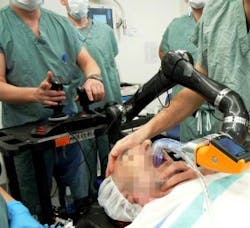McGill develops first vision-guided, tube-insertion robot for medical procedures
The first intubation robot operated by remote control--the Kepler Intubation System (KIS)--has been developed by Dr. Thomas M. Hemmerling and his team at McGill University Health Centre (MUHC; Montreal, QC, Canada). Themedical robot may facilitate the intubation procedure and reduce some complications associated with airway management. The world's first robotic intubation in a patient was performed at the Montreal General Hospital earlier this month by Dr. Hemmerling.
"The KIS allows us to operate a robotically mountedvideo-laryngoscope using a joystick from a remote workstation," says Dr. Hemmerling who is also a neuroscience researcher at the Research Institute of the MUHC. "This robotic system enables the anaesthesiologist to insert an endotracheal tube safely into the patient's trachea with precision."
The insertion of an endotracheal tube allows artificial ventilation, which is used in almost all cases of general anesthesia. Correct insertion of this tube into patients' airways is a complex manoeuvre that requires considerable experience and practice to master. "Difficulties arise because of patient characteristics but there is no doubt that there are also differences in individual airway management skills that can influence the performance of safe airway management," says Dr. Hemmerling. "These influences may be greatly reduced when the KIS is used."
After successfully performing extensive tests in the airways of medical simulation mannequins, which closely resemble intubation conditions in humans, clinical testing in patients has now begun.
"High tech equipment has revolutionized the way surgery is done, allowing the surgeon to perform with higher precision and with almost no physical effort - I believe that the KIS can do for anesthesia what these systems have done for surgery," says Dr. Armen Aprikian, Director of MUHC's Department of Urology who performed surgery on the first patient treated using the KIS.
"We think that KIS can assist the anesthesiologist's arms and hands to perform manual tasks with less force, higher precision and safety. One day, it might actually be the standard practice of airway management," concludes Dr. Hemmerling, whose laboratory developed the world's first anesthesia robot, nicknamed McSleepy, in 2008.
SOURCE:McGill University Health Centre
--Posted byVision Systems Design
